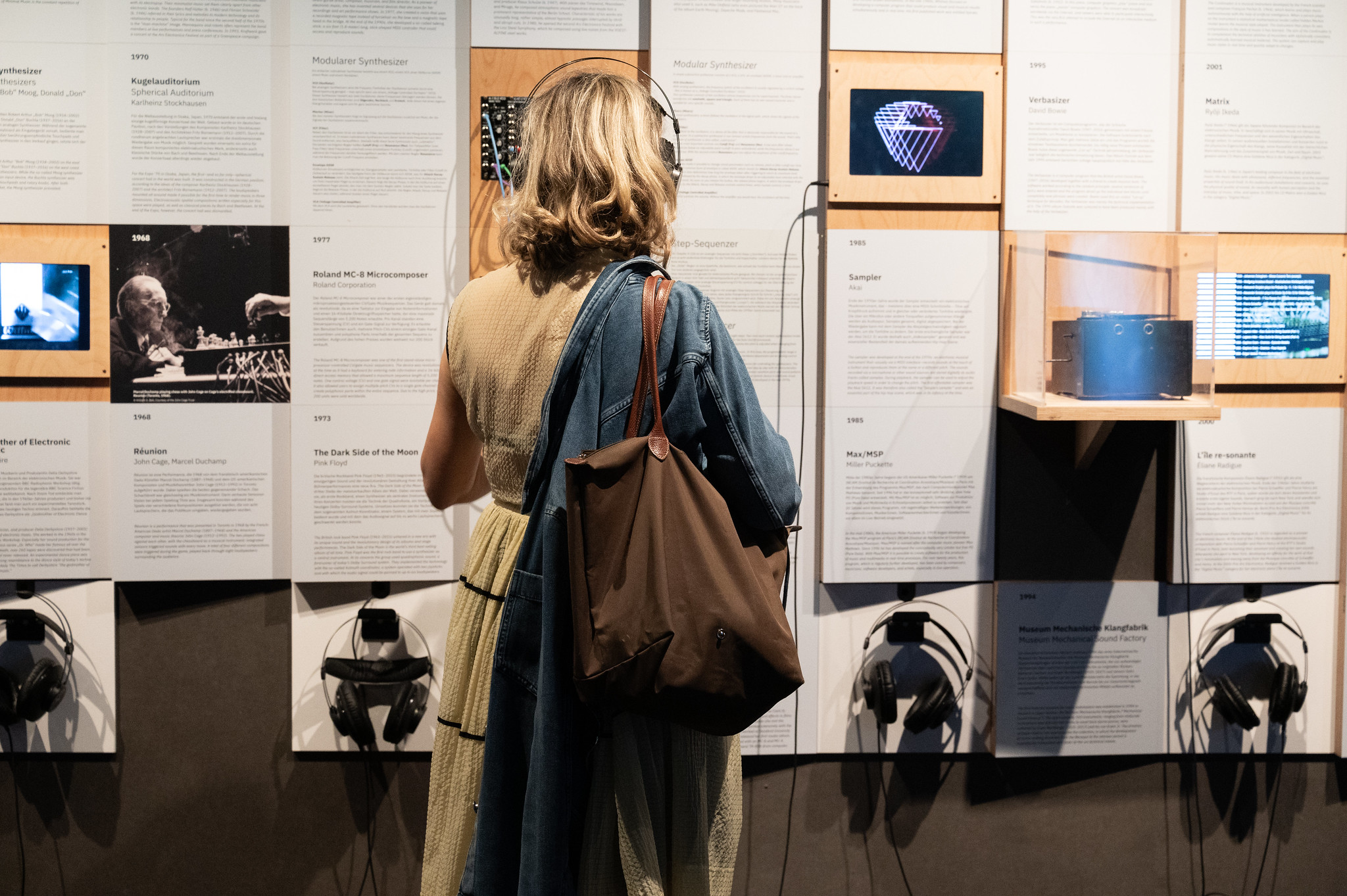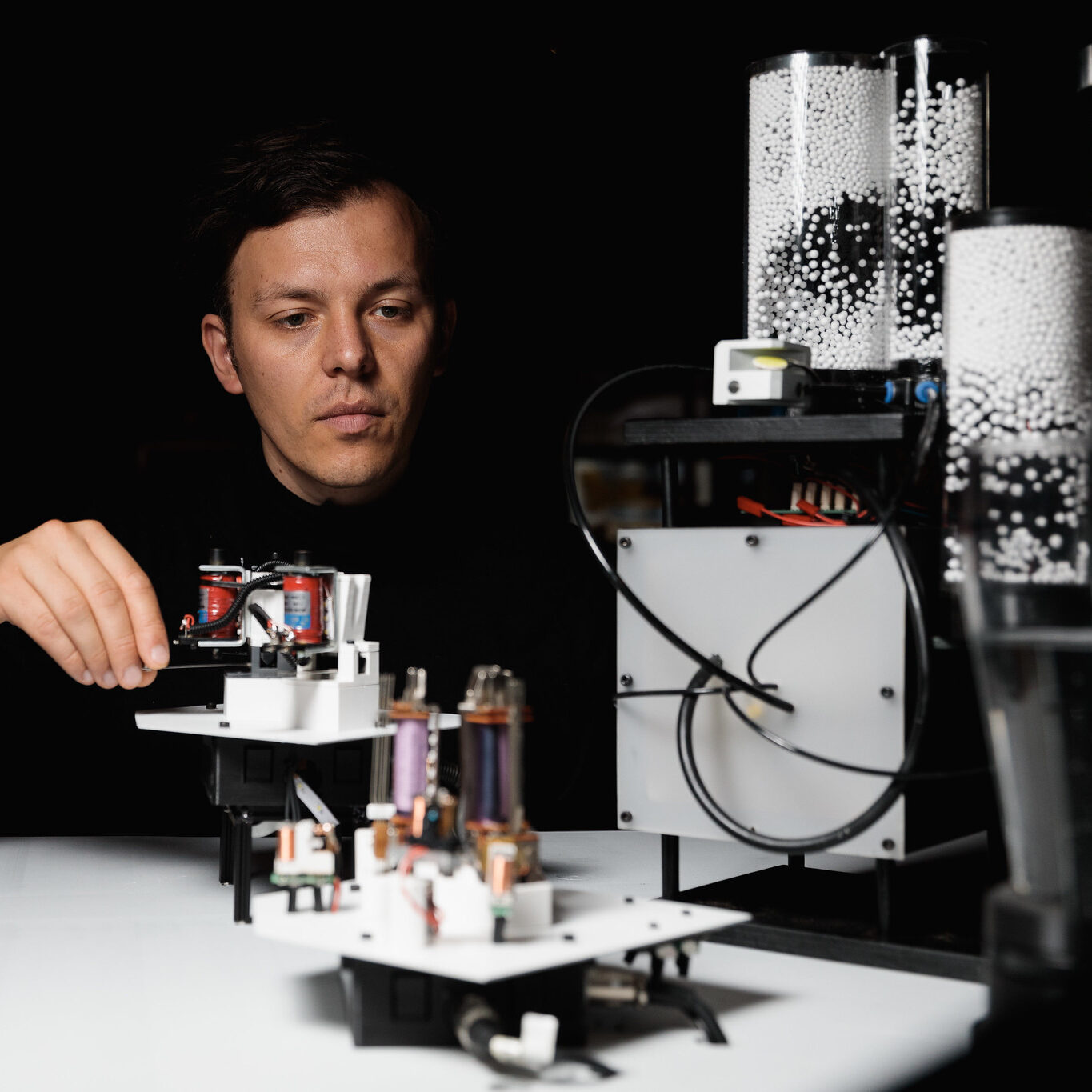In the AI x Music exhibition, the Ars Electronica Center not only presents the very latest ideas, developments and inventions in the context of technology and music, it also deals with the past.
On a vertical area of around 16 square meters visitors can explore the most interesting developments of history, also placing the exhibits in a chronological way. A small selection from the 3rd century BC to the present can be found here:
3rd century BC
The Water Clock of Archimedes
Archimedes
The Greek mathematician, physicist, and engineer Archimedes (ca. 287–212 BC), regarded as the father of hydrostatics—the science of immobile, flow-free liquids—is considered the inventor of the water clock, called clepsydra. Although the original document in which this clock is mentioned no longer exists, records of the device were found in later Arabic translations. This is a very large and elaborate water clock that has many additional functions and objects that move automatically, and that can also produce musical sounds.
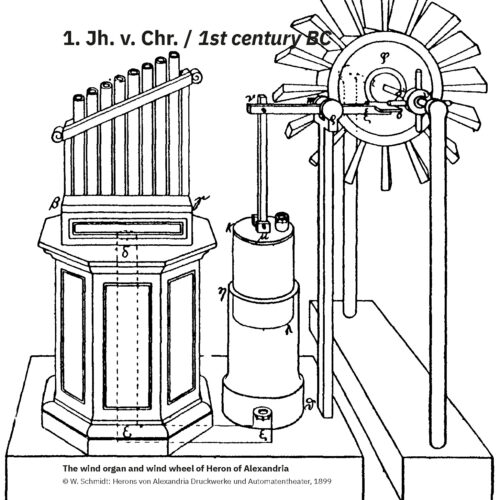
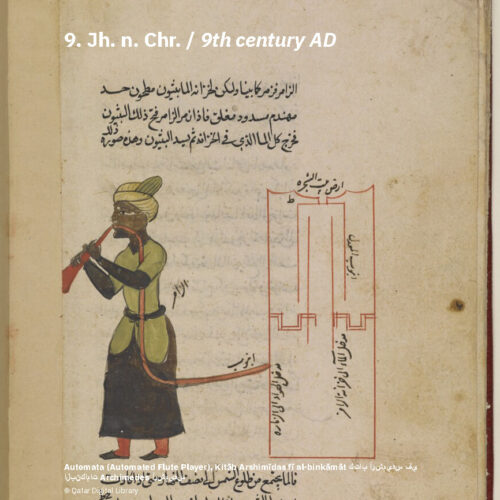


9th century AD
Automatic flute
Banū-Mūsā-Brüder
The oldest programmable machine is an automatic flute invented in the ninth century AD by the Banū Mūsā brothers under the title The instrument that plays by itself. This music machine consists of a roller with pins on it. As soon as the roller rotates, the pins actuate levers that open one or more of the nine holes of a flute. The airflow for the flute is generated by water filling a container, forcing the air to escape. The roller is driven by a water wheel.
9th century AD
A Robot Band
Al-Jazarī
The Arab engineer and author Al-Jazarī (1136–1206) invented a boat with four“musicians” on it: it floated on a lake and entertained guests at royal drinkingevents. In fact, it was a programmable music machine, consisting of a drummachine that hit small levers with pins to operate drums. The programmingconsisted of changing the arrangement of the pins. Depending on how theywere arranged, the drums played different rhythms and patterns.The Arab engineer and author Al-Jazarī (1136–1206) invented a boat with four “musicians” on it: it floated on a lake and entertained guests at royal drinking events. In fact, it was a programmable music machine, consisting of a drum machine that hit small levers with pins to operate drums. The programming consisted of changing the arrangement of the pins. Depending on how they were arranged, the drums played different rhythms and patterns.
1618
The Harmonious Law
Johannes Kepler
In 1618 Johannes Kepler (1571–1630) discovered his third law on planetary motion: it describes the relationship between orbit time and orbit radius of two planets, which he understood as essential geometrical-harmonic regularity. Kepler’s third law was published in 1619 in his work Harmonices mundi libri V. In this five-part publication Kepler tried to fathom the harmonic principles in the divine creation.
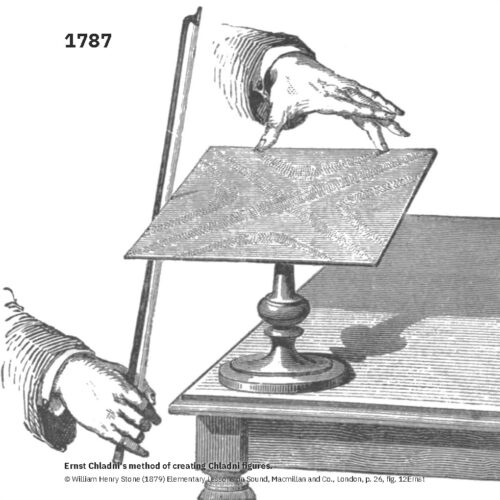


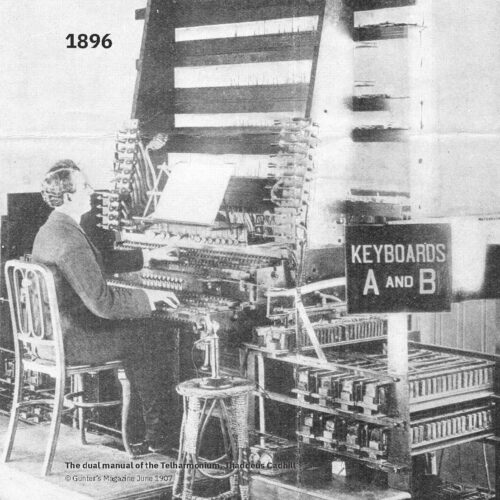
1793
Mozart’s Musical Dice Game
Wolfgang Amadeus Mozart
The Instructions for Composing Waltzes by Means of Two Dice is perhaps the best-known musical dice game. It probably goes back to Wolfgang Amadeus Mozart (1756–1791) and was published in 1793, long after his death. Two dice are used to randomly select small sections of music that are then joined to form a piece of music. This random principle can be used to produce 1116 different but similar waltzes 45,949,729,863,572,161, or almost fifty quadrillion compositions
1815
The Mälzel Metronome
Johann Nepomuk Mälzel, Ludwig van Beethoven
The German mechanic and organ builder Dietrich Nikolaus Winkel (1777–
1826) developed the Music Chronometer in Amsterdam in 1814, a metronome he designed based on Johann Nepomuk Mälzel’s ideas. In 1815, however, Mälzel patented the metronome in his name. He improved the metronome and had large quantities of them produced in factories in Paris and London. When Winkel heard about this, a legal dispute arose, which ended in 1820 in favor of Winkel. Since Mälzel’s metronome was very different from Winkel’s, some contemporaries were of the opinion that Mälzel was the lawful inventor of the metronome.
1843
The First Programmer
Ada Lovelace
The British mathematician Ada Lovelace (1815–1852) played a major role in the design of the Analytical Engine as Charles Babbage’s assistant, which was highly unusual for women at that time. In a treatise from 1843 she describes how Bernoulli numbers could be calculated with the help of the machine — and thus the first computer program. Her visions of being able to process musical notes, letters, and images with a machine were also revolutionary.


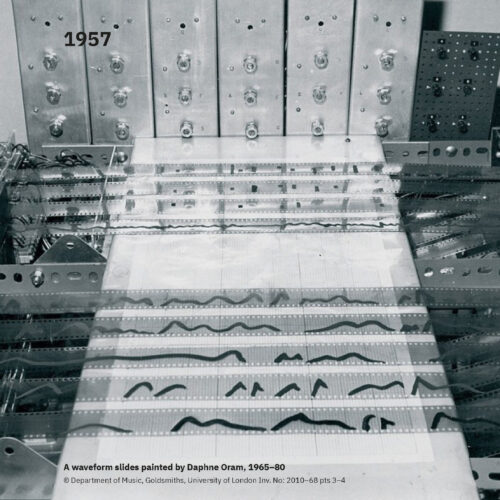

1949
Digital Music from the Computer
Trevor Pearcey, Maston Beard
The first Austrian museum for music automatons was established in 1994 in Haslach in Upper Austria: the Museum Mechanische Klangfabrik [“Mechanical Sound Factory”]. The approximately 160 instruments, ranging from elaborate orchestrions and delicate bell clocks to novel back-borne pianos, were collected by Erwin Rechberger (1925–2017) and his son Erwin Jr. The province of Upper Austria has now acquired the collection, in which the development of music-making machines from the Baroque to the interwar period is scientifically researched with state-of-the-art technical means.
1950
MUSIC I
Max Mathews
His development of the program MUSIC I made the American electrical
engineer Max Mathews (1926–2011) a pioneer of computer music. In contrast to the CSIRAC of 1949, where raw impulses were sent to the loudspeaker, the program developed by Mathews was able to generate digital audio signals for the first time, resulting in a real sound. A seventeen-second melody generated by an IBM 704 computer in 1957 using MUSIC I, is now considered by music researchers to be the founding date of computer music.
1963
The The Godmother of Electronic
Dance Music
Delia Derbysh
The British composer, musician, and producer Delia Derbysh (1937–2001)
was a pioneer in the field of electronic music. She worked in the 1960s in the
so-called BBC Radiophonic Workshop. Especially her sound production for the
legendary BBC science fiction series „Dr. Who“ made her famous all over the
world. In 2008, after her death, over 260 tapes were discovered that had been
produced in the 1960s and never released. An experimental dance piece was
also found that bears a strong resemblance to the dance style of today’s techno
music, leading the British daily The Times to call Derbyshire “the godmother of
modern electronic dance music.”
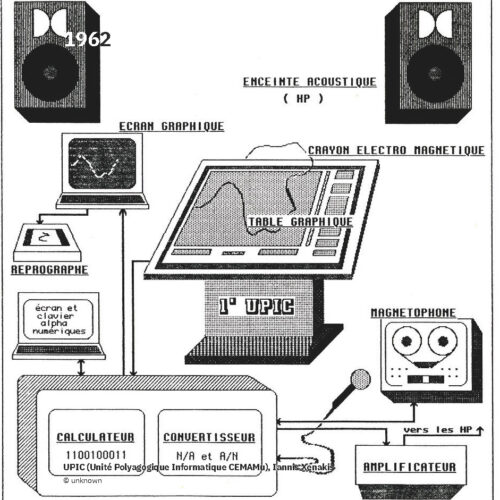
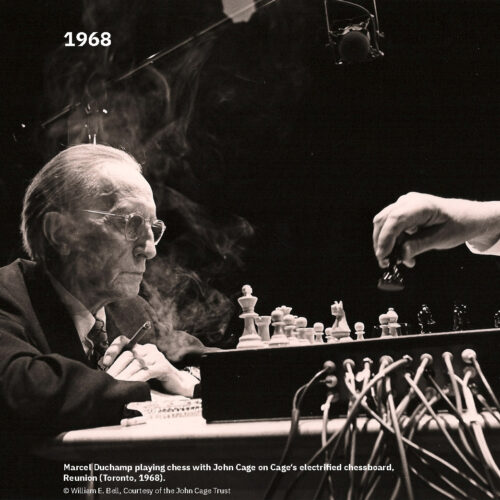


1973
Kraftwerk
Ralf Hütter, Florian Schneider
The German band Kraftwerk, founded in 1970, influenced countless musicians
with its electropop. Their minimalist music set them clearly apart from other
electronic bands. The founders Ralf Hütter (b. 1946) and Florian Schneider
(b. 1946) referred in their lyrics and melodies to modern technology and its
relationship to people. Typical for the band since the second half of the 1970s
is the “man-machine” image. Mannequins and robots often represent the band
members at live performances and press conferences. In 1993, Kraftwerk gave
a concert at the Ars Electronica Festival as part of a Greenpeace campaign.
1978
The First Drum Computers
The first drum computers appeared in the 1930s. Almost fifty years later the
first programmable devices were developed. In contrast to an electronic drum
set, the drum computer has, in addition to drum pads, an interface and a builtin
pattern sequencer that can be used to program rhythms. Up to the model
Linn LM-1 the sound generation was analog. It was the first programmable
drum computer to use digital samples from an acoustic drum set.
1994
Museum Mechanical Sound Factory
The first Austrian museum for music automatons was established in 1994 in Haslach in Upper Austria: the Museum Mechanische Klangfabrik [“Mechanical Sound Factory”]. The approximately 160 instruments, ranging from elaborate orchestrions and delicate bell clocks to novel back-borne pianos, were collected by Erwin Rechberger (1925–2017) and his son Erwin Jr. The province of Upper Austria has now acquired the collection, in which the development of music-making machines from the Baroque to the interwar period is scientifically researched with state-of-the-art technical means.

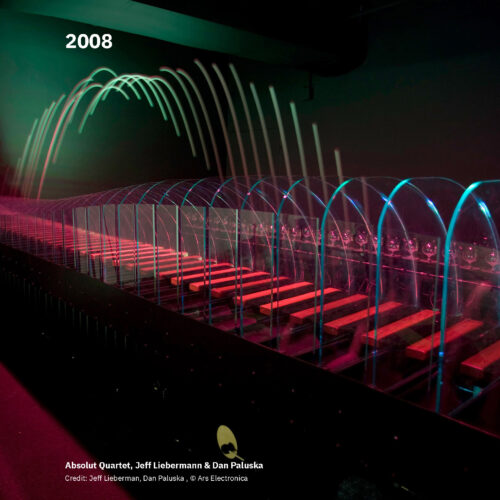


1995
Verbasizer
David Bowie
The Verbasizer is a computer program that the British artist David Bowie
(1947–2016) developed together with a friend to create musical texts. The
software worked according to the random principle: several sentences of
lyrics were entered and the program diced up the individual text blocks until
completely new phrases were created. Bowie used this so-called “cut-up”
technique for decades; the Verbasizer was merely the technical implementation
of it. The 1995 album Outside was rumored to have been produced mainly with
the help of the Verbasizer.
2009
Deus Cantando
Peter Ablinger, Winfried Ritsch, Thomas
Musil, Institute for Electronic Music and
Acoustics Graz
Deus Cantando is a media art installation that plays with our brain’s
interpretation abilities. When a button is pressed, the piano begins to play
autonomously with a total of eighty-eight electromechanical fingers. At first
abstract sounding musical structures can be heard, but when one reads the
text projected on a wall, it becomes clear that the sounds of the piano imitate
the human voice. The text “spoken” by the piano is the 2009 proclamation of
the International Environmental Court
2015
THE ELECTRIC KNIFE ORCHESTRA
Neil Mendoza
The British media artist Neil Mendoza (b. 1977) has built an orchestra of
six music machines from a total of sixteen knives and a meat cleaver, which
together perform the Bee Gees’ 1977 hit Stayin’ Alive. The programmed
everyday objects make music by moving bells, touching triangles, or conducting
voltages. Everything functions as if by magic: six separate switching systems,
programmed in advance by Mendoza, operate the music machines.
2018
Robotic Electronic Music
Moritz Simon Geist
Robotic Electronic Music is the first techno album that exclusively features
robots. It was produced by the media artist and musician Moritz Simon Geist
(b. 1981). Every sound on this record is produced by robots, from small motors
hitting metal and 3D-printed kalimbas vibrating to old bits of discarded hard
disks clicking and cutting. All robots were built by Geist over the course of
several years.
2019
Simple Harmonic Motion Series
Memo Akten
The Turkish-born media artist, researcher, and philosopher Memo Akten
(b. 1975) uses images and sounds in his works that are all driven by the same
mathematical principles and algorithms: a complex signal that is broken down
into its basic elements and operates at different frequencies. Simple Harmonic
Motion is an ongoing series of works that explores complexity by starting from
simplicity—especially the emergence of complex behavior through the interplay
of simple multi-layered rhythms.
2019
MuseNet
OpenAI
With MuseNet, OpenAI has created a deep neural network that can create fourminute musical compositions with different instruments. It combines different music styles from country to Mozart to the Beatles. MuseNet doesn’t compose like a human would: it tries to find out which “building block” should best be used next in the composition. It was trained with hundreds of thousands of MIDI files; from this pool, the artificial intelligence decides for itself what fits
best.
